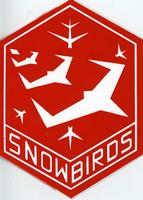431 Air Demonstration Squadron – The Snowbirds

"The quality performance of precision aerobatics and the high visibility of the Snowbird team have been of considerable benefit to Canadian aviation."
Aerobatics teams have been a part of Canada's aviation heritage for over six decades, beginning in 1929 with a biplane team called The Siskins. The year 1959 was an important year in the history of aviation in Canada: it was the 50th anniversary of powered flight, as well as the 35th anniversary of the Royal Canadian Air Force (RCAF). A Golden Anniversary aerobatics team, called the Golden Hawks, was authorized for one year. Using gold-painted F-86 Sabre 5's, the team performed sixty five 25-minute shows across Canada from May to the end of September. They were so popular that it was decided to continue the team, and shows were performed again, thrilling millions of people at airshows across Canada and the United States. They were acclaimed the best team in North America, and were the pride of the RCAF and heroes to the young across the country. However, they were disbanded after the 1963 shows were finished because of the high cost of maintaining the team.
Canada celebrated its 100th birthday in 1967 with a new team called the Golden Centennaires flying Tutor Jets. This team performed 100 air shows across Canada and the U.S., captivating audiences wherever they went.
In 1969 Colonel O.B. Philp, who had created and commanded the Centennaires, was promoted to Base Commander at Moose Jaw, Saskatchewan, operating No. 2 Canadian Forces Flying Training School, commonly known as “The Big Two”. On his first tour of the base, he spotted several all-white CL-41 Tutors, ex-Centennaire machines, among the unpainted metal remainder.
The recent unification of the Armed Forces had created insecurity among senior Army, Navy and Air personnel, so without seeking permission, Philp encouraged 'practice' for formation demonstrations. This 'practice' was intended to maintain instructor pilots' proficiency, and their appearance across the country was hailed by the public, and gradually became an accepted fact by the top brass. In 1970 a white Tutor led the formation of four which opened the Regina football season, and at the Abbotsford Air Show that year, all four Tutors were white.
In 1971 the four became seven, a logo was developed, and a competition among school children gave the Snowbirds their name. In 1972 two solos were added to make up their present complement of nine aircraft. That year, team members were assigned to practice and performance full time.
In 1974 the aircraft were painted with the familiar red, white and blue paint scheme, and were authorized to do a fully acrobatic show. One of the reasons the shows are such crowd-pleasers is the choice of the Canadair CL-41 Tutor jet trainer as their team aircraft. The exceptional maneouverability of this aircraft allows the Snowbirds to stay in constant contact with spectators, giving a seamless performance.
Seven years after their first show, the Snowbirds achieved full squadron status as No. 431 Air Demonstration Squadron, and have gradually developed into one of the world's foremost aerobatics team.
The Snowbirds' aim is to demonstrate to the North American public the skill, professionalism and team work of the Canadian Forces. Snowbirds strive for perfection in formation flight. They draw upon the spirit and example of those who have served before them. Since 1971, the team has embarked on a continuing journey as Canadian ambassadors of excellence in aerial displays.
The Belt of Orion Award for Excellence was bestowed upon No. 431 (AD) Squadron, the Snowbirds, in 1994 at a ceremony held at Edmonton, Alberta.
The entire “Snowbird” squadron consists of only 24 members, including 11 pilots, 10 aircraft technicians, 1 logistics officer, 1 supply technician and a civilian secretary. The team members are all volunteers of the Canadian Forces and their tour of duty with the Snowbirds is two years. Each year, half the team members change, with the new members being taught the required skills by the second year Snowbirds.
